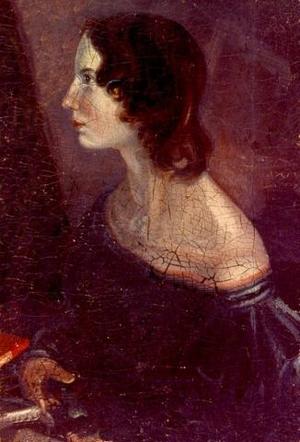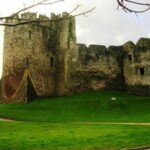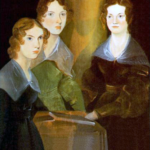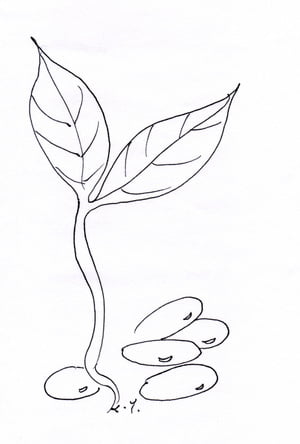Emily Bronte’s only major novel, Wuthering Heights, was published in 1847. In this novel, there are instances of tragic romances, the Byronic hero and of multiple narrators. Also included are certain supernatural elements at Wuthering Heights, which contrast the lighter setting of Thrushcross Grange. In fact, certain specific gothic themes, occurring in the mid-Victorian era, appear in Wuthering Heights locale, including: the appearance of ghosts, a haunted setting and a proprietor who is equated with a hellish abyss. There is a symmetry within Bronte’s novel, as the gothic imagery of Wuthering Heights is ever more apparent when compared to the more whimsical and lighter tones in the setting of Thrushcross Grange. Wuthering Heights is associated with the natural and the inherent supernatural elements found therein; Thrushcross Grange is simply more civilized. There are other contrasting features which show the symmetry in the novel, especially the characterizations. Edgar Linton is a civilized, yet impotent and powerless man, when faced with Heathcliff’s wilder power. Catherine and Heathcliff’s love is stagnant, while Cathy and Hareton’s romance is progressive. There is ever a duality in Bronte’s novel and this symmetry is the founding structure of the novel. Therefore, the appearance of the gothic is essential to the novel. This paper will explore certain gothic elements which occur, including: the use of ghosts to set an atmosphere of horror, the importance of situating Wuthering Heights in the moors and how Bronte suggests that Heathcliff is tied to the supernatural, in the final chapters, especially Chapter XXXIV. This will establish the gothic tones of Wuthering Heights, which create one half of this novel’s symmetry.
The early gothic revival had begun by the mid 19th Century and by 1850 the High Victorian Gothic was in full swing (Hitchcock 47). The gothic novel included elements of “haunted castles, supernatural occurrences…and ghost-story devices”(Hume 282). Bronte introduces these elements early in her novel. Catherine’s ghost showsherself to the character Lockwood; here, she reminisces of her punishment to walk the earth for twenty years (Bronte 22). Her appearance could be dismissed as a dream of Lockwood’s and offering natural occurrences for the appearance of gothic elements is a device often used in gothic novels (Hume 282). In the early chapters, Bronte is setting Wuthering Heights in the gloomier tones of the High Victorian Gothic, which is in a sharp contrast to the lighter tones of Thrushcross Grange. This contrast is setting up a battle between the evil of Heathcliff with that of the calmer and more benevolent Edgar Linton.
The two settings of Wuthering Heights and Thrushcross Grange establish the light and dark tones of the novel. There can be little doubt that Wuthering Heights is haunted and that this setting has a hold on the character Heathcliff, who broods about this abode as if possessed by a demonic force. In Chapter XXXIV, Heathcliff is often described by the housekeeper, Nelly, as a ghoul or a vampire (Bronte 282) and even the character himself has visions of hell: “I am on the threshold of hell” (Bronte 281). As well, Wuthering Heights is set on the moors, which in themselves are dangerous to the characters and their presence further establishes the wildness of Wuthering Heights. Thrushcross Grange, on the other hand, is situated on more fertile land and this second setting is more equated with safety, rather than death. Wuthering Heights seems to draw the reader further down into the abyss, while Thrushcross Grange tries to alleviate the gloom from the first half of the novel. The novel is structured in such a way that Wuthering Heights is central to the story for the first half of the novel, while the second half is predominantly set in Thrushcross Grange. The use of Thrushcross Grange in the second portion of the book is showing Bronte’s ability to balance out the elements of the wild and the civilized, with the supernatural and the literal, Thus, the novel ends in lighter, more hopeful tones. Unfortunately, Heathcliff is unable to leave Wuthering Heights due to its supernatural hold upon him. His ties to the ghost of Catherine and to this haunted abode create much of the tension between him and Edgar Linton and between Wuthering Heights and Thrushcross Grange.
Comparing Heathcliff to the demonic further cements Bronte’s novel in the gothic genre. Heathcliff is at the center of Wuthering Heights and therefore, he is at the center of the evil that resides therein. He is equated with evil or demonic characters often within the final chapter: “those deep black eyes! That smile, and ghastly paleness! It appeared to me, not Mr. Heathcliff, but a goblin” (Bronte 282). His association with the supernatural and his residence in a place of evil not only suggest that Heathcliff is the villain, but that his motivations are the result of demonic possession. Heathcliff’s actions throughout the novel are often dishonourable e.g. his motivation for revenge. And the descriptions of Heathcliff being associated with hell are often given by the other characters in the story. No other character is described this way. The reason for Heathcliff’s terrible curses upon others and his foul mood are explained by his connection with the supernatural and with the evil present at Wuthering Heights.
The characters at Thrushcross Grange remain good, while balancing the evil designs and supernatural motivations of Heathcliff. As well, the setting of Wuthering Heights establishes the gothic tones of the novel by equating this setting with darker, more horrifying elements, when compared to Thrushcross Grange. Thrushcross Grange draws the novel away from this darkness and into lighter tones. These contrasting elements help to establish the symmetry of the novel. This symmetry also helps to create a unity in the piece, while the gothic tones clearly show that Wuthering Heights set in the Mid-Victoria period.
Works Cited
Hitchcock, Henry-Russell. “High Victoria Gothic.” Victorian Studies 1.1 Sept. (1957): 47-71. Print.
Hume, Robert D. “Gothic versus Romantic: A Revaluation of the Gothic Novel.” Modern Language Assoc.
84.2 Mar. (): 282-90. Print.






